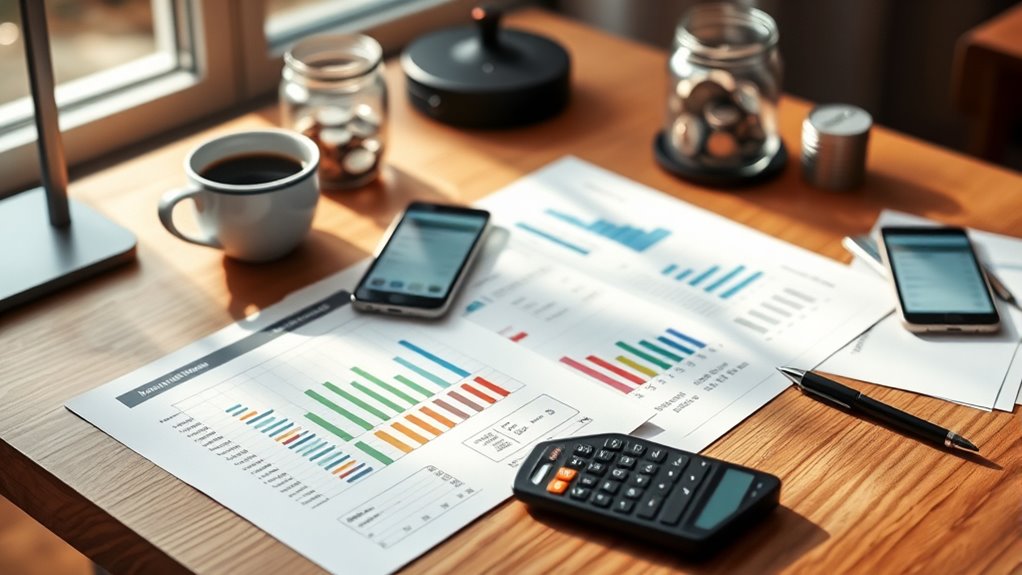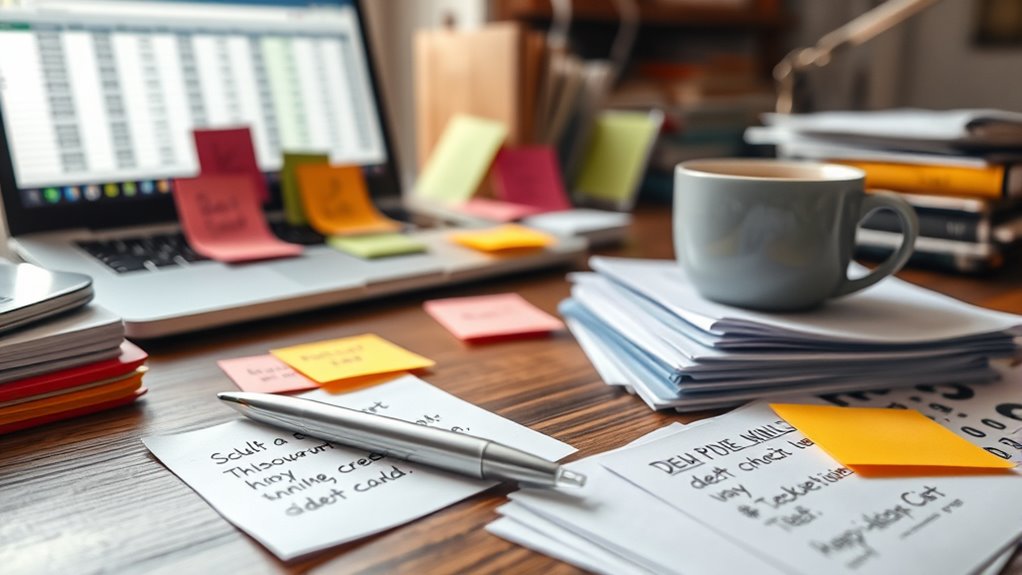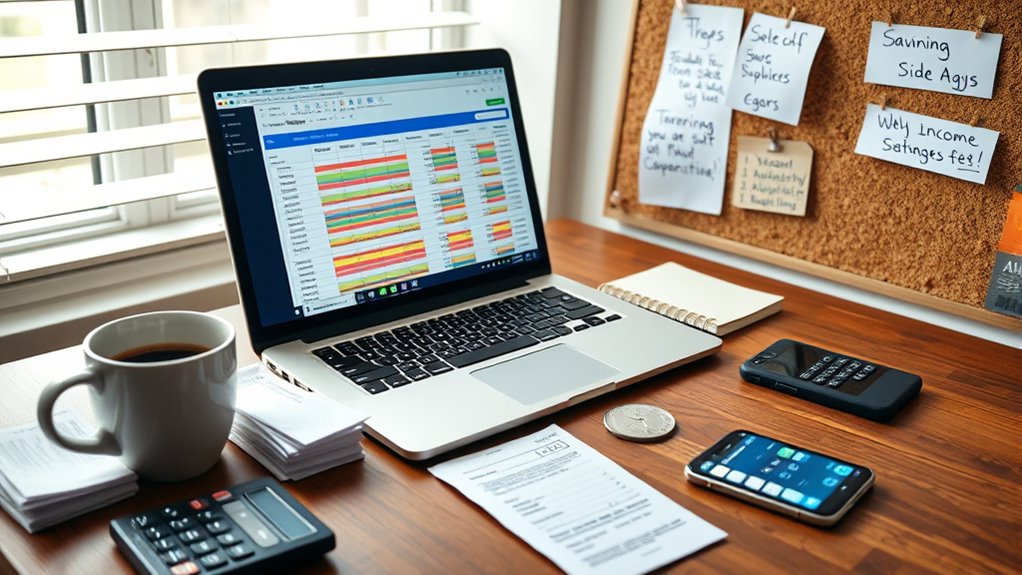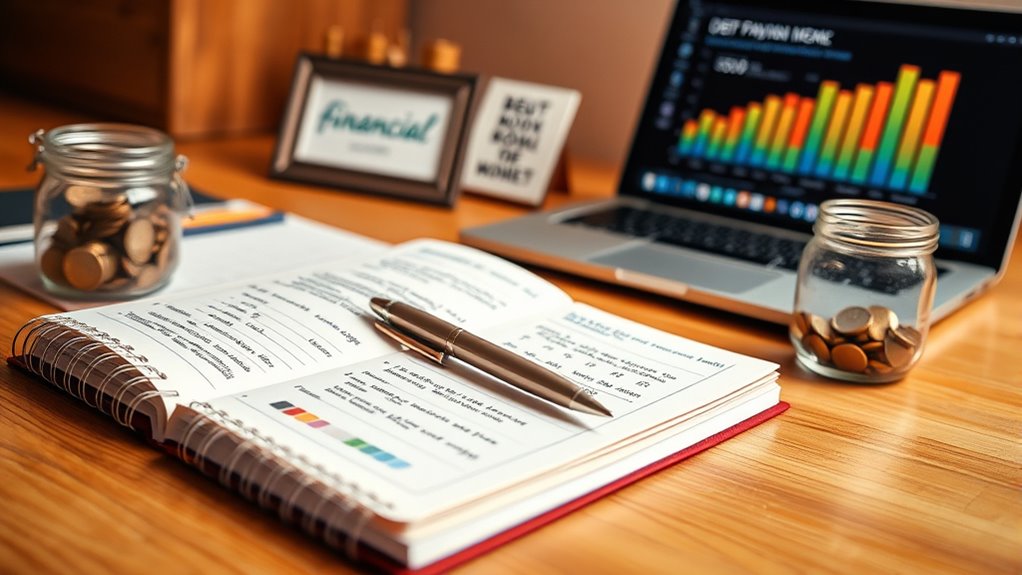To manage personal debt effectively, start by evaluating your entire debt situation, including balances and interest rates. Create a realistic budget that tracks your spending, identifies necessary expenses, and finds areas to cut back. Prioritize your debts using either the avalanche or snowball method, and consider extra income sources to speed up repayment. Stay motivated by setting clear goals and tracking your progress regularly—if you continue, you’ll discover ways to strengthen your debt payoff strategy further.
Key Takeaways
- Assess all debts, including balances and interest rates, to prioritize repayment effectively.
- Create a realistic budget that tracks expenses, reduces unnecessary spending, and allocates extra payments toward debt.
- Choose a repayment strategy, such as avalanche or snowball, to systematically pay down debts.
- Monitor progress regularly using visual tools and adjust plans as circumstances change.
- Maintain motivation by setting clear goals, celebrating milestones, and aligning debt payoff with personal values.
Assessing Your Current Debt Situation

Before you can create an effective plan to manage your debt, you need to understand exactly where you stand financially. Start by gathering all your financial statements, including bills, credit card statements, loans, and bank account details. List every debt you owe, noting the balance, interest rate, and minimum monthly payment. This gives you a clear picture of your total debt load and the types of debt you’re dealing with. Knowing whether your debts are high-interest credit cards or lower-interest loans helps you prioritize repayment strategies. Be honest about your current financial situation, including your income and expenses. This assessment forms the foundation for making informed decisions and taking control of your debt. Understanding your debt structure can help you choose the most effective repayment methods. Additionally, recognizing your financial habits can reveal areas where you might cut costs or adjust spending to accelerate debt repayment. Being aware of your credit utilization can also influence your ability to negotiate better terms or improve your credit score over time. Incorporating tuning principles such as optimizing your financial setup can further enhance your debt management efficiency. Furthermore, practicing mindfulness in your financial decisions can help you stay focused and reduce impulsive spending, supporting your repayment goals.
Creating a Realistic Budget and Spending Plan

Creating a realistic budget and spending plan is essential for gaining control over your finances and paying down debt effectively. Start by tracking all your income and expenses for a month to understand where your money goes. Identify necessary expenses like rent, utilities, and groceries, then pinpoint areas where you can cut back, such as dining out or entertainment. Set clear, achievable spending limits based on your income and debt repayment goals. Use tools like spreadsheets or budgeting apps to stay organized and monitor your progress regularly. Be honest about your spending habits, and adjust your plan as needed. A well-crafted budget keeps you accountable, prevents overspending, and ensures you’re making steady progress toward becoming debt-free. Incorporating budgeting tools can further improve your financial management and help maintain discipline. Additionally, understanding the role of contrast ratio and other visual elements can motivate you to create a more engaging and motivating financial tracking system. Regularly reviewing your spending habits can help identify patterns and opportunities for further savings. Staying aware of financial literacy concepts can empower you to make smarter money decisions and improve your overall financial health, especially when combined with a clear understanding of your income and expenses.
Prioritizing and Tackling Your Debts

To effectively reduce your debt, you need to prioritize which debts to pay off first and develop a clear plan of attack. Start by listing all your debts, noting the balances, interest rates, and minimum payments. Then, decide whether to use the avalanche method—focusing on high-interest debts first—or the snowball method—paying off the smallest balances first for quick wins. Once you’ve chosen your approach, allocate extra payments to your top priority debt while maintaining minimum payments on others. Consistency is key; stay disciplined and avoid adding new debts. Regularly review your progress and adjust your plan if needed. Prioritizing your debts helps you stay organized, reduces interest costs, and accelerates your journey toward becoming debt-free. Understanding credit management strategies can further enhance your ability to stay on track and prevent future debt issues. Effective debt repayment methods are essential for maintaining financial stability and avoiding long-term financial burdens. For those interested in asset division strategies during divorce, understanding how to manage and allocate assets can be crucial in minimizing financial strain. Exploring electric bikes can provide an eco-friendly way to commute and potentially save money on transportation. Additionally, considering budgeting tools can help you stay on track and visualize your financial goals more effectively.
Exploring Additional Income Sources and Savings Tips

Once you’ve established a plan to tackle your debts, boosting your income and trimming expenses can accelerate your progress. Look for ways to earn extra cash, such as freelancing, selling unused items, or taking on part-time work. These additional funds can go directly toward paying off debt faster. Simultaneously, review your expenses and identify areas to save—cancel unused subscriptions, cook at home more often, or shop smarter. Automate savings by setting up automatic transfers to your savings account, making it easier to build a financial cushion. Small changes add up over time, helping you reduce debt quicker. Incorporating additional income sources like side gigs or part-time jobs can significantly speed up your debt payoff journey. Additionally, understanding financial habits can help you make more mindful decisions, preventing future debt accumulation. Exploring debt repayment strategies can also provide targeted approaches to clearing your debts more efficiently. Implementing effective budgeting techniques can further optimize your financial plan, ensuring that every dollar works toward your goal. Remember, combining increased income with mindful spending creates a powerful strategy to reach your debt-free goal sooner. Incorporating smart financial planning can help you stay on track and make informed decisions throughout your debt repayment process.
Staying Motivated and Tracking Your Progress

Staying motivated while paying off debt can be challenging, but maintaining focus is key to your success. To keep momentum, celebrate small wins, like paying off a single debt or hitting a savings milestone. Use visual tools like charts or apps to track your progress; seeing your debt decrease can boost your morale. Set clear, achievable goals to stay focused and avoid feeling overwhelmed. Regularly review your financial plan to adjust for changes and stay on course. Keep reminding yourself of your reasons for becoming debt-free, whether it’s financial freedom or peace of mind. Staying consistent and monitoring your progress helps you stay motivated and committed, turning a formidable task into a manageable journey. Additionally, being aware of goal tracking pitfalls can help you avoid common mistakes that may hinder your progress. Incorporating self-awareness into your financial strategy can further improve your ability to stay disciplined and focused on your goals, especially when you understand the importance of financial discipline in achieving long-term success. Recognizing the role of existential themes in personal motivation can deepen your commitment to your debt repayment journey. Utilizing tools like password strength meters can enhance your security awareness, which is crucial when managing sensitive financial information.
Frequently Asked Questions
How Can I Negotiate Lower Interest Rates With Creditors?
You can negotiate lower interest rates with your creditors by calling them directly and explaining your financial situation honestly. Be prepared to demonstrate your payment history and stability, and ask if they can offer a better rate or a hardship plan. Sometimes, just requesting a review of your account can lead to reduced rates. Stay polite and persistent, as creditors are often willing to help loyal customers.
What Legal Options Are Available for Debt Relief?
Oh, the irony of legal options for debt relief—who knew laws could be your debt’s best friend? You can file for bankruptcy to wipe out or restructure debts, or negotiate a debt settlement to reduce what you owe. You might also explore debt management plans through credit counseling. These options are designed to help you regain control, turning the legal system from a foe into an ally in your financial recovery.
How Do I Balance Debt Repayment With Building an Emergency Fund?
Balancing debt repayment with building an emergency fund can seem tough, but it’s doable. You should prioritize paying off high-interest debt first, while setting aside a small amount each month—say 10%—to build your emergency fund gradually. Automate transfers to make it easier, and once your debt is under control, increase your savings. Consistency is key; small steps lead to financial security over time.
What Should I Do if I Face a Financial Setback?
When you face a financial setback, first assess your situation honestly. Cut non-essential expenses and temporarily pause extra debt payments if needed. Contact your creditors to explain your situation and explore hardship options, like payment deferrals. Focus on rebuilding your emergency fund gradually, and consider additional income sources if possible. Staying proactive and flexible helps you regain control and minimize long-term impacts on your financial health.
How Can I Avoid Falling Into Debt Again After Paying It Off?
Imagine you’ve just paid off your credit card debt. To avoid falling back in, create a budget that tracks your expenses and sets aside savings. Limit discretionary spending, like dining out or shopping. For example, if you decide to save $200 monthly, you’ll build an emergency fund and reduce the temptation to borrow. Consistently practicing financial discipline helps you stay debt-free and maintain long-term stability.
Conclusion
By taking control of your debt, you’re steering your financial ship toward calmer waters. Remember, every small step counts and keeps you moving forward. Stay committed, celebrate your milestones, and don’t let setbacks sink your spirits. With patience and persistence, you’ll watch your debt melt away like snow in the sun. Keep your eyes on the horizon—your debt-free future is closer than you think, waiting just beyond the next wave of effort.










